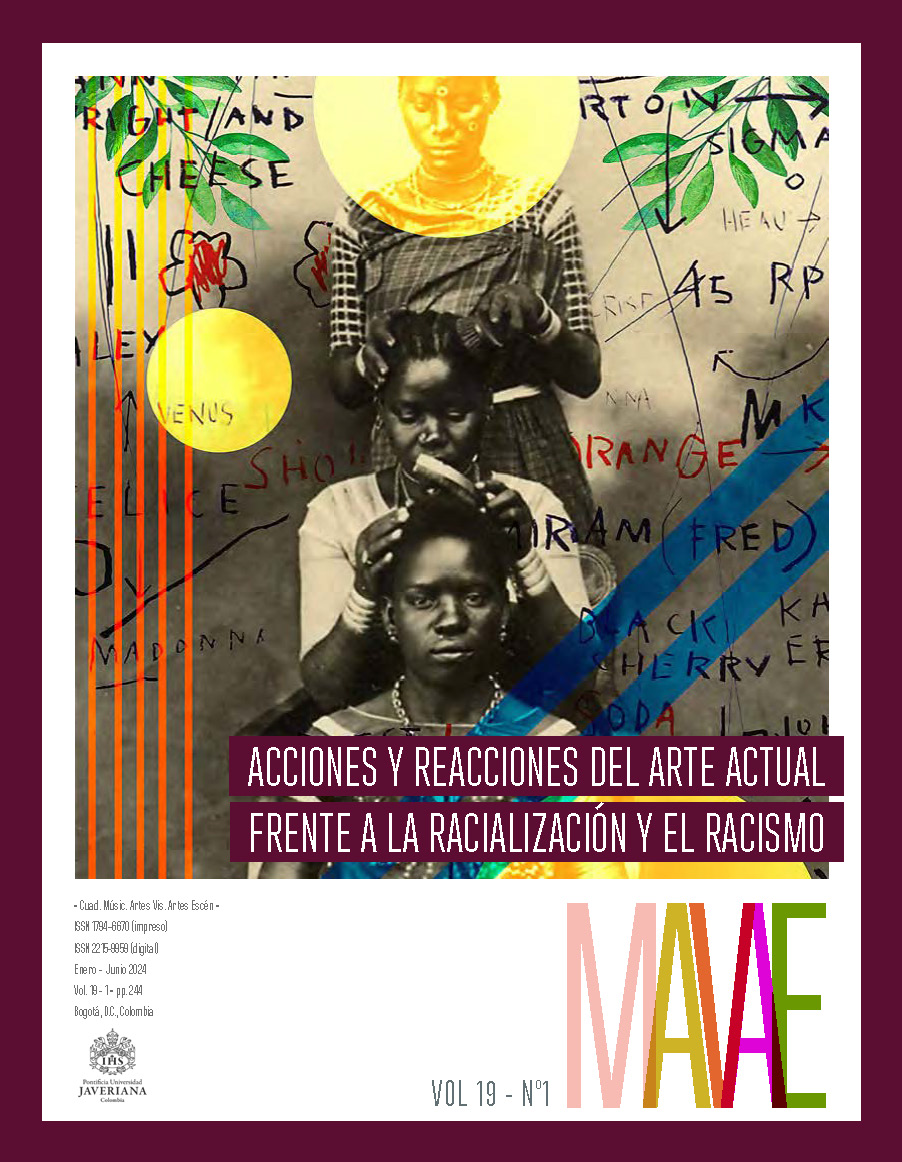Abstract
This article presents the thoughts around the results of an audience research which employed the approach of digital ethnography to learn about the interactions and perceptions among the audiences and followers of the afro-contemporary dance artistic group Sankofa Danzafro from Medellín and a collective of activists around champeta music that promotes its patrimonialization in Cartagena. An account is made of the methodology and experiences of working with the followers of the artistic groups on social networks and the anti-racist strategies of the artistic practices and their effects on the audiences are analyzed. Subversion, irruption and affective interpellation on the audiences were the three strategies identified in the analysis. Among the results of the study, we observed that anti-racist artistic practices affect audiences by combining aesthetic elements, body narratives, the message and a popular pedagogical intention that are intertwined with the identified strategies.
Anderson, Ben. 2009. “Affective Atmospheres”. Emotion, Space and Society 2, n.º 2: 77-81. https://doi.org/10.1016/j.
emospa.2009.08.005
Bárcenas Barajas, Karina y Nohemí Preza Carreño. 2019. “Desafíos de la etnografía digital en el trabajo de campo onlife”. Virtualis 10,
n.º 18: 134-151. https://doi.org/10.2123/virtualis.v10i18.287
Clifford, James y George E. Marcus, eds. 1991. Retóricas de la antropología. Barcelona: Júcar.
Clifford, James y George E. Marcus. 2010. Writing Culture: The Poetics and Politics of Ethnography, 1986. Berkeley: University of
California Press.
Cunin, Elisabeth. 2003. Identidades a flor de piel: Lo “negro” entre apariencias y pertenencias. Categorías raciales y mestizaje en
Cartagena. Instituto Colombiano de Antropología e Historia. “En el Congreso cuestionaron la decisión del Concejo local de pasar a prohibir ese baile por considerarlo ‘erótico’”. 2015. El Espectador, 6 de noviembre. https://www.elespectador.com/politica/es-exagerado-prohibir-la-champeta-en-colegios-de-cartagenaarticle-
/
Geertz, Clifford. 1989. El antropólogo como autor. Barcelona: Paidós.
Geertz, Clifford. 2001. La interpretación de las culturas. Barcelona:Gedisa.
González, Ricardo. 2016. “La práctica artística contemporánea como experiencia interdisciplinar abierta al aprendizaje
transversal”. Arte y Políticas de Identidad 14: 51-68. https://doi.
org/10.6018/280481
Hellebrandová, Klára. 2014. “Escapando a los estereotipos (sexuales) racializados: El caso de las personas afrodescendientes de clase
media en Bogotá”. Revista de Estudios Sociales 49: 87-100.https://journals.openedition.org/revestudsoc/8441
LaViolette, Forrest y K. H. Silvert. 1951. “A Theory of Stereotypes”.Social Forces, 29, n.º 3: 257-62. https://doi.org/10.2307/2572414
Marcus, George E. 2001. “Etnografía en/del sistema mundo: El surgimiento de la etnografía multilocal”. Alteridades, n.º 22:
-127. https://alteridades.izt.uam.mx/index.php/Alte/article/view/388/387
Marxen, Eva. 2018. “Artistic Practices and the Artistic Dispositif: A Critical Review”. Antípoda, n.º 33: 37-61. https://doi.org/10.7440/
antipoda33.2018.03
Miller, Daniel y Heather A. Horst. 2020. “The Digital and the Human: A Prospectus for Digital Anthropology”. En Digital
Anthropology, editado por Heather A. Horst y Daniel Miller, 3-35. Nueva York: Routledge.
Mosquera, Sergio Andrés. 2018. “Estereotipos sexo-raciales alrededor de las ‘comidas negras’: Estudio en la ciudad de Medellín”. Tesis
de maestría. Universidad de Antioquia. https://bibliotecadigital.udea.edu.co/bitstream/10495/10039/1/MosqueraSergio_2018_
EstereotiposSexoRaciales.pdf
Palacios Garrido, Alfredo. 2009. “El arte comunitario: Origen y evolución de las prácticas artísticas colaborativas”. Arteterapia: Papeles
de arteterapia y educación artística para la inclusión social 4: 197-211. https://revistas.ucm.es/index.php/ARTE/article/view/
ARTE0909110197A/8795
Perkins, Tessa E. 1979. “Rethinking Stereotypes”. En Routledge Revivals: Ideology and Cultural Production, editado por Michele Barrett,
Philip Corrigan, Annette Kuhn y Janet Wolff, 135-159. Nueva York:
Routledge. https://doi.org/10.4324/9781351063142
Rancière, Jacques. 2000. “Política, identificación y subjetivación”. En El reverso de la diferencia: Identidad y política, editado por Benjamín
Arditi, 145-152. Caracas: Nueva Sociedad. http://148.202.18.157/sitios/catedrasnacionales/material/2010a/cristina_palomar/6.pdf
Rancière, Jacques. 2009. El reparto de lo sensible: Estética y política.Buenos Aires: Prometeo.
Ruiz Méndez, María del Rocío y Genaro Aguirre-Aguilar. 2015. “Etnografía virtual: Un acercamiento al método y a sus aplicaciones”. Estudios
sobre las Culturas Contemporáneas, n.º 41: 67-96. https://www.redalyc.org/pdf/316/31639397004.pdf
Salzman, Philip Carl. 2002. “On Reflexivity”. American Anthropologist 104,n.º 3: 805-811. https://doi.org/10.1525/aa.2002.104.3.805
Tapia, María Lourdes. 2016. “Los vínculos interpersonales en las redes sociales: Nuevos modos de comunicación en el marco de una universidad argentina”. Espacio Abierto: Cuaderno Venezolano de Sociología 25, n.º 4: 193-202. https://www.redalyc.org/articulo.oa?id=12249087015
University of Manchester. 2023. “Contexto de la investigación”. https://sites.manchester.ac.uk/carla/home/es/sobre/contexto-de-lainvestigacion/
Van Dijk, Teun A. 2012. “The Role of the Press in the Reproduction of Racism”. En Migrations: Interdisciplinary Perspectives, editado
por Michi Messer, Renee Schroeder y Ruth Wodak, 15-29.Vienna: Springer.

This work is licensed under a Creative Commons Attribution 4.0 International License.
Copyright (c) 2023 Carlos Correa Angulo, Rossana Alarcón Velásquez


